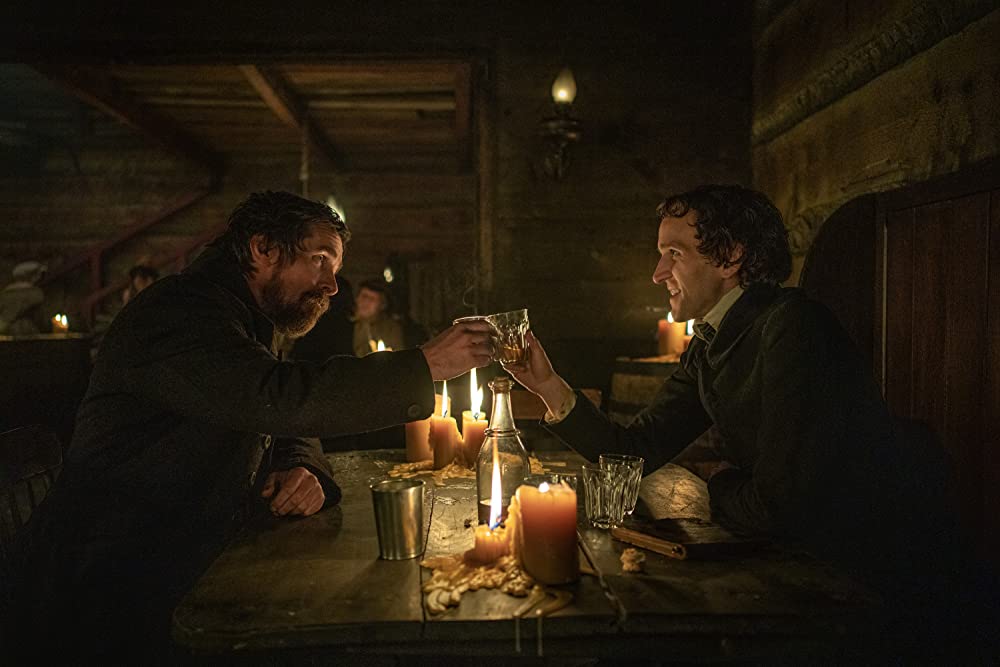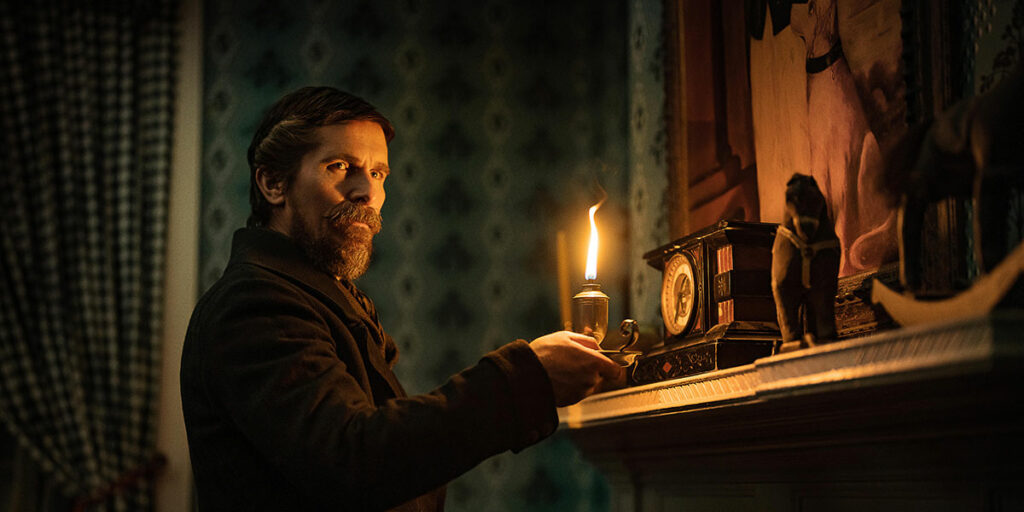The Pale Blue Eye features a top-notch performance from Harry Melling as Edgar Allan Poe, in service of a beautiful, subversive, melancholy mystery film.
The Pale Blue Eye is a murder mystery period piece starring Christian Bale as Augustus Landor, a renowned detective who’s called upon to investigate the hanging of a U.S. military cadet (Steven Maier) in West Point in 1830. He’s joined by another cadet, Edgar Allan Poe (Harry Melling)… yes, that Edgar Allan Poe, as his literary expertise proves useful in the search for the killer’s M.O. But when more murders take place during the investigation, we’re shown a darker, seedier underbelly within the military academy that leads to truths in places certain characters wouldn’t have imagined.
I was looking forward to The Pale Blue Eye, partially because of its cast and setting, and partially because it’s directed and written by Scott Cooper, who most recently made the highly underrated Antlers in 2021. And with The Pale Blue Eye getting the same level of middling reviews that Antlers got, I’m starting to wonder if I just gel with Cooper’s style in a way many others don’t.
The Pale Blue Eye is no masterpiece, but it’s an extremely well put together period mystery with so much more to offer than the middling buzz may have you believe. The Netflix movies I’ve seen have been getting more consistent at standing visually toe-to-toe with most theatrical films, and The Pale Blue Eye is no exception. It boasts lush cinematography from Masanobu Takayanagi, who I know from films like The Grey and Warrior. Most of this film takes place during the winter, and he gets so many beautiful shots featuring dark shadows and eerie nighttime fog against the snow, perfectly invoking the same gothic atmosphere that Poe’s own stories often do.
Howard Shore’s score is also great, generally soft and atmospheric with just the right level of a sweeping undercurrent. Even something as simple and obvious as the sharp sound of fire crackling as two men work on a dour case goes so far in immersing the viewer in this environment. I’m very disappointed and confused that The Pale Blue Eye was given such a pitiful chance in theaters. It’s not some incredible spectacle, but had it been playing in more theaters, I’d have loved to see it on the big screen. But it’s been established with Glass Onion’s one-week theatrical window that Netflix hates having their movies make money, so what can you do?

Bale and Melling are instantly magnetic together. Bale’s performance is as great as you’d expect, but Melling completely disappears as the offbeat, enthusiastic Poe and nearly steals the whole movie right out from under him. There’s really no reason for this character to be specifically Poe outside of some clear references to the writer’s work … but honestly, who cares? Watching him put pieces together and interact with every character in his own unique way is so entertaining yet sincere that I would honestly watch a whole film series or show about Edgar Allan Poe solving more cases. Maybe a crossover with detectives like Hercule Poirot and Benoit Blanc? If we can get three live-action Spider-Men in the same movie, we can make this happen!
But as The Pale Blue Eye continues, it gets a little hard to discern what makes it that thoughtful a story or mystery, which is where I can understand the overall more lukewarm reception. The setup is solid and everyone is established well enough, especially with an eerie opening shot that perfectly sets the tone, but a lot of what makes this film work as well as it does isn’t clear until you have the entire picture. A few branching plotlines seem to run in parallel with one another as opposed to building off each other.
New relationships are formed that don’t seem essential at first, the possibilities for connective threads between murders aren’t really focused on, and sometimes when a subplot is cut back to, I forgot it was even happening. The film is over two hours long, and I did feel that length and sometimes thought it could have been trimmed down. But not to an overbearing degree. Never did The Pale Blue Eye feel like it was completely losing track of itself, and I never ended up bored. Just when it felt like those things were about to happen, the film pulled the focus back to where it should be and the momentum was salvaged.
What elevates The Pale Blue Eye from a good but standardly written film to a great one is the ending. Just when you think we’ve had our climax and everything is about to wrap up, another sequence of big reveals completely recontextualizes everything about the entire film in a new, unsettling way. Not only are the two central performances at their best in this final stretch, but the very nature of the mystery we’ve been watching is rewritten into something that brings every seemingly disparate event together in a much more personal way. This includes a type of reveal that I don’t think I’ve ever seen in a murder mystery. I have to assume it’s been done before somewhere (and massive credit to the original book, of course), but this is my first time seeing it, and it’s a brilliant subversion of the very nature of this genre. I’ve said before that I’m a sucker for murder mysteries with unconventional explanations, and this definitely falls into that category. And funnily enough, the idea actually ran through my head at one point during the movie, so I wouldn’t even say it comes out of nowhere!
The Pale Blue Eye was already a solid enough film from the very beginning, but looking back on it really gives me another level of appreciation for it. I love the characters and performances, I love the look and setting, and I love the specific way it pulls the rug out from under us in the end. It feels very authentic to its time period, right down to the more sophisticated dialogue, and it tells a tale that would fit right into a lineup of stories from Poe himself. The pacing is uneven and can definitely throw people off, but if the movie’s starting to lose you, I definitely recommend staying with it all the way through. Scott Cooper’s really stepping up as one of the more interesting directors out there, and I say that as someone who really didn’t like the first film I saw from him, 2015’s Black Mass. He’s won me over since then, and I’m definitely looking forward to following his work now.
The Pale Blue Eye is now available to watch on Netflix.

